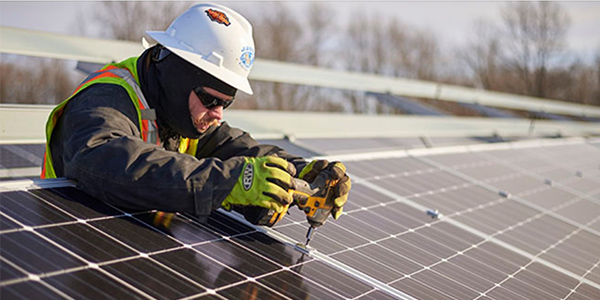By Amanda Durish Cook
Michigan regulators last week approved a settlement between Consumers Energy and solar developers, resolving arguments over the utility’s obligation to support small generation projects under the Public Utility Regulatory Policies Act.
The Public Service Commission’s approval of the agreement means that Consumers will interconnect new solar projects and is allowed to establish a new avoided-cost rate (ACR) for qualifying facilities (U-20615).
Consumers will now purchase power from an additional 584 MW worth of solar projects to be interconnected by 2023. About 170 MW of the projects will receive the current ACR, while the remaining 414 MW will be eligible to enter contracts at a rate based on MISO LMPs plus the capacity prices established in the RTO’s annual capacity auction. Solar developers Geronimo Energy, Cypress Creek Renewables and sPower stand to receive a cut of the first 170 MW of projects at higher rates.
The move will more than triple solar capacity in Michigan, which currently has more than 153 MW of solar. The settlement puts to rest five separate cases between Consumers and more than 40 entities. The settlement was signed by several QFs, Consumers, PSC staff and the Solar Energy Industries Association.
Under PURPA, utilities such as Consumers are obligated to purchase electricity from independently owned QFs at rates that reflect a utility’s own cost to build new generation. Consumers’ existing avoided costs generally range from about $95 to $110/MWh, but the company has alleged the figures are outdated and above-market.
While the settlement will put some QFs in operation, its leaves many awaiting approval and compensation from Consumers. The company’s current PURPA interconnection queue is jammed at 3.3 GW, and several QF owners complained that the first version of its integrated resource plan didn’t do enough to clear the backlog. Consumers has previously mounted an unsuccessful bid with its state regulators to waive deadlines on reviewing QF applications for approval. The utility claimed it was simply overwhelmed by the more than 1,700 QF applications in the pipeline.
A previous settlement in June modified Consumers’ IRP so that the utility will now conduct an annual competitive bidding supervised by a third party for adding new capacity (U-20165). Consumers can only own up to half of the new capacity it secures through competitive bidding; the rest must come from power purchase agreements with unaffiliated companies. Any remaining capacity needs after bidding is complete can be filled by QFs.
Consumers this fall will bid out about 1,200 MW of new solar energy for the 2019-2021 time frame. Although the bidding will focus on solar generation, the utility said QFs of all fuel types will be allowed to bid.
The June settlement also stipulates that Consumers will use a five-year horizon instead of the previous 10-year outlook to determine whether it has a capacity need. Consumers will also have to file new ACRs for regulatory approval within 30 days of each annual bidding process. Current QFs with a PURPA-based contract will continue to get new PPAs regardless of Consumers’ capacity needs. Additionally, QFs 150 kW or smaller will receive PPAs based on the full avoided cost, also regardless of Consumers’ capacity status.
Last year, Michigan regulators lifted a 10-month suspension on the state’s new avoided-cost calculation for Consumers. The utility argued it didn’t need any additional capacity over the next 10 years and had put about 700 MW of solar projects on hold. The PSC rejected the argument, saying the utility’s IRP would determine whether it needed new capacity.
PURPA in Flux
Michigan isn’t the only state in the MISO footprint where utilities have tried to alter or discontinue their obligation to pay independent developers under PURPA, arguing that rates exceed actual avoided costs for new generation.
The 9th U.S. Circuit Court of Appeals ruled in June that it could not force the Montana Public Service Commission to compel NorthWestern Energy to purchase power from solar developers at originally established and higher ACRs. (See Montana PSC Racks up 2nd Lawsuit over PURPA Rates.)
FERC this summer also avoided addressing whether the addition of storage facilities at the Beaver Creek wind farm in Montana would put the project’s QF standing in jeopardy under PURPA when the owner withdrew applications to recertify the four 80-MW projects (EL18-195). NorthWestern argued last year that the addition of storage units to 80-MW wind facilities would put them over the PURPA megawatt limit.
In comments to the petition, the Edison Electric Institute said the case raised new issues for PURPA’s treatment of energy storage and urged FERC to hold off on deciding on the motion until it could address the issues of “modernizing” PURPA in a more comprehensive proceeding, given that on-site storage capability could increase a facility’s capacity beyond 80 MW.
FERC has been reviewing its implementation of the law since 2016, holding a technical conference in June of that year, but it has languished under numerous shakeups at the commission. However, one of its agenda items (E-1) for this month’s open meeting Thursday concerns “qualifying facility rates and requirements” and “implementation issues” under PURPA. The item is listed under both the docket FERC opened in 2016 (AD16-16) and a new rulemaking docket (RM19-15), indicating a Notice of Proposed Rulemaking is potentially imminent.





